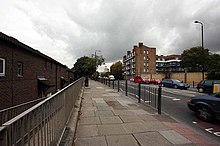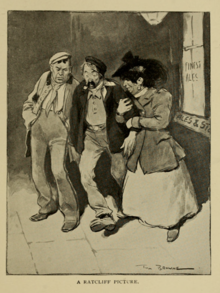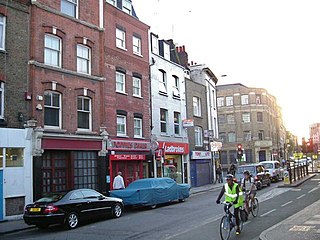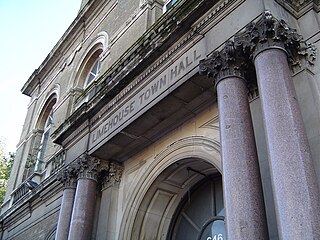
Limehouse is a district in the London Borough of Tower Hamlets in East London. It is 3.9 miles (6.3 km) east of Charing Cross, on the northern bank of the River Thames. Its proximity to the river has given it a strong maritime character, which it retains through its riverside public houses and steps, such as The Grapes and Limehouse Stairs. It is part of the traditional county of Middlesex. It became part of the ceremonial County of London following the passing of the Local Government Act 1888, and then part of Greater London in 1965.

Wapping is a district in East London in the London Borough of Tower Hamlets. Wapping's position, on the north bank of the River Thames, has given it a strong maritime character, which it retains through its riverside public houses and steps, such as the Prospect of Whitby and Wapping Stairs. It also has a Royal Navy shore establishment base on the riverfront called HMS President and home to Tobacco Dock and King Edward Memorial Park.

The London Borough of Tower Hamlets is a borough of London, England. Situated on the north bank of the River Thames and immediately east of the City of London, the borough spans much of the traditional East End of London and includes much of the regenerated London Docklands area. The 2019 mid-year population for the borough is estimated at 324,745.

The Rotherhithe Tunnel, designated the A101, is a road tunnel under the River Thames in East London, connecting Limehouse in the London Borough of Tower Hamlets north of the river to Rotherhithe in the London Borough of Southwark south of the river. It was formally opened in 1908 by George, Prince of Wales, and Richard Robinson, Chairman of the London County Council. It is a rare example of a road tunnel where road traffic, pedestrians and cyclists all share the same tunnel bore. Transport for London took over ownership and maintenance of the tunnel in 2001.

The Metropolitan Borough of Stepney was a Metropolitan borough in the County of London created in 1900. In 1965 it became part of the London Borough of Tower Hamlets.

Shadwell is a district of East London, England, in the London Borough of Tower Hamlets, 3 miles (4.8 km) east of Charing Cross. It lies on the north bank of the Thames between Wapping and Ratcliff. This riverside location has meant the area's history and character have been shaped by the maritime trades.

Ratcliff or Ratcliffe is a locality in the London Borough of Tower Hamlets. It lies on the north bank of the River Thames between Limehouse, and Shadwell. The place name is no longer commonly used.
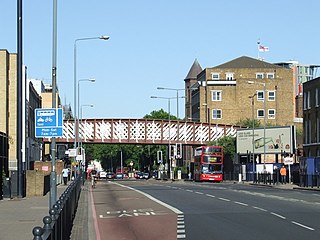
Commercial Road is a street in the London Borough of Tower Hamlets in the East End of London. It is 1.9 miles (3.1 km) long, running from Gardiner's Corner, through Stepney to the junction with Burdett Road in Limehouse at which point the route splits into the East India Dock Road and the West India Dock Road. It is an artery connecting the historic City of London with the more recently developed financial district at Canary Wharf, and part of the A13.
The Ratcliff Highway murders were two attacks on two separate families – the Marr and Williamson families – that resulted in seven fatalities. The two attacks occurred twelve days apart in December 1811, in homes located half a mile apart near the London Docklands district of Wapping, London, England, United Kingdom. The main suspect in the slayings, John Williams, killed himself before he could be put on trial.
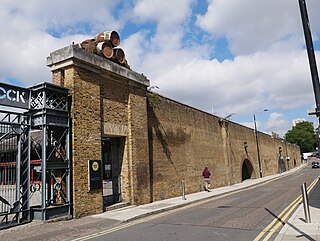
Tobacco Dock is a Grade I listed warehouse located in the East London district of Wapping, and thereby the London Borough of Tower Hamlets. Part of the London Docks designed by Scottish civil engineer and architect John Rennie, the warehouse was completed in 1812 and primarily served as a store for imported tobacco, hence the name. During the early 20th century, economic activity in the area fluctuated due to World War I and World War II, and both London Docks and nearby St Katharine Docks had closed by 1969.

Nathaniel Heckford (1842–1871) was a paediatrician in Victorian London, who founded the East London Hospital for Children. He met his future wife, Sarah Goff, during the 1866 cholera epidemic in Wapping, where he first determined a need for a children's hospital in the East End of London. Heckford died of tuberculosis at the age of 29.

Shadwell Basin is a housing and leisure complex built around a disused dock in Wapping, London. The old dock was formerly part of the London Docks, a group of docks built by the London Dock Company at Shadwell and Wapping as part of the wider docks of the Port of London.

The Grapes is a public house situated directly on the north bank of the Thames in London's Limehouse area, with a veranda overlooking the water. To its landward side, the pub is found at number 76 in Narrow Street, flanked by former warehouses now converted to residential and other uses. It is listed Grade II on the National Heritage List for England.

London Buses route 100 is a Transport for London contracted bus route in London, England. Running between St Paul's station and Shadwell station, it is operated by London Central.

Wellclose Square is a public square in the London Borough of Tower Hamlets, between Cable Street to the north and The Highway to the south.

Limehouse was a local government district within the metropolitan area of London, England from 1855 to 1900.

St George in the East, historically known as Wapping-Stepney, was an ancient parish, in the London Borough of Tower Hamlets, England. The place name is no longer widely used.

King Edward Memorial Park is a public open space in the London Borough of Tower Hamlets, on the northern bank of the River Thames.
